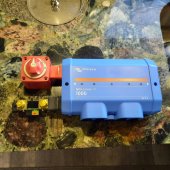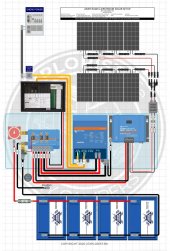Pappion
Retired Engineer Tech
- Joined
- Nov 26, 2020
- Messages
- 552
That Lynx Power In is just a glorified bus bar. The upper scale model has fuse mounts and monitoring.
This is what I used: 250A per post, 4 posts
Also, most of the current will circulate between battery and inverter/converter. I would run inverter/converter positive directly to the cutoff switch, and the negative to the shunt. Hint: Both the Shunt and the switch can have 2 wires on terminals.
This is what I used: 250A per post, 4 posts
Also, most of the current will circulate between battery and inverter/converter. I would run inverter/converter positive directly to the cutoff switch, and the negative to the shunt. Hint: Both the Shunt and the switch can have 2 wires on terminals.
Last edited:






